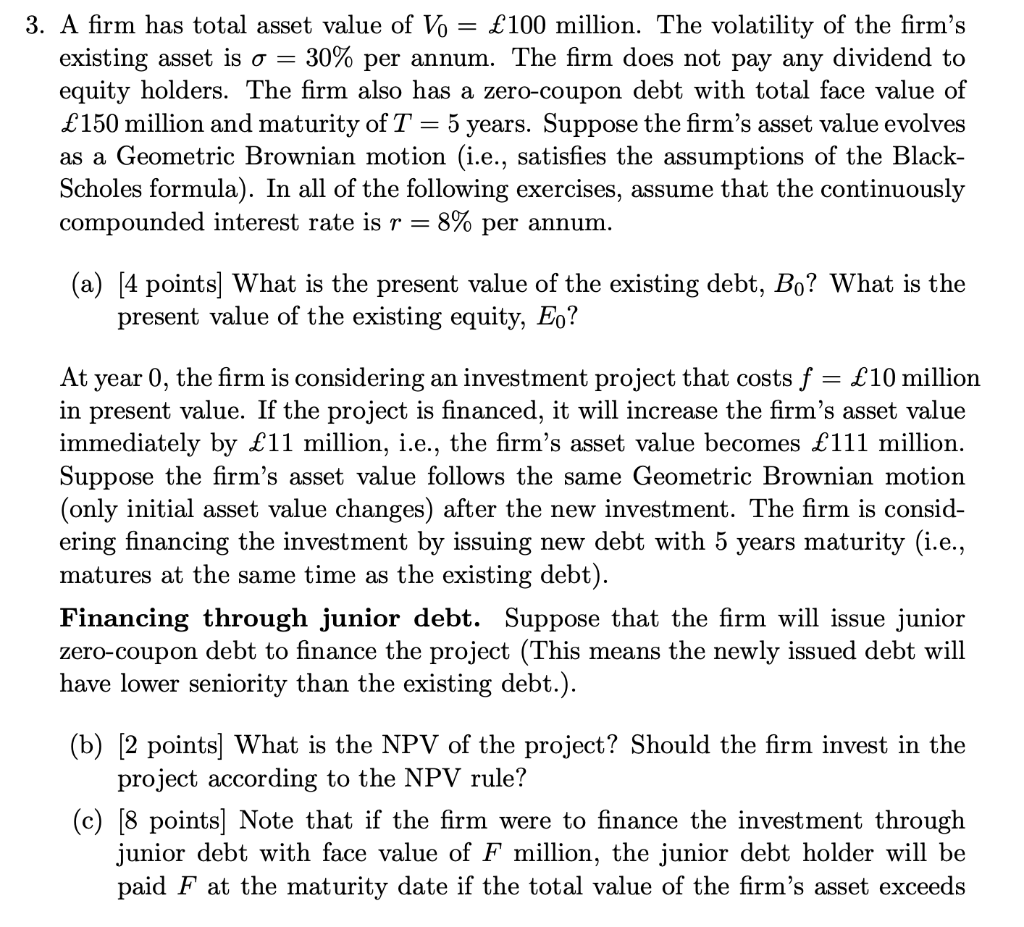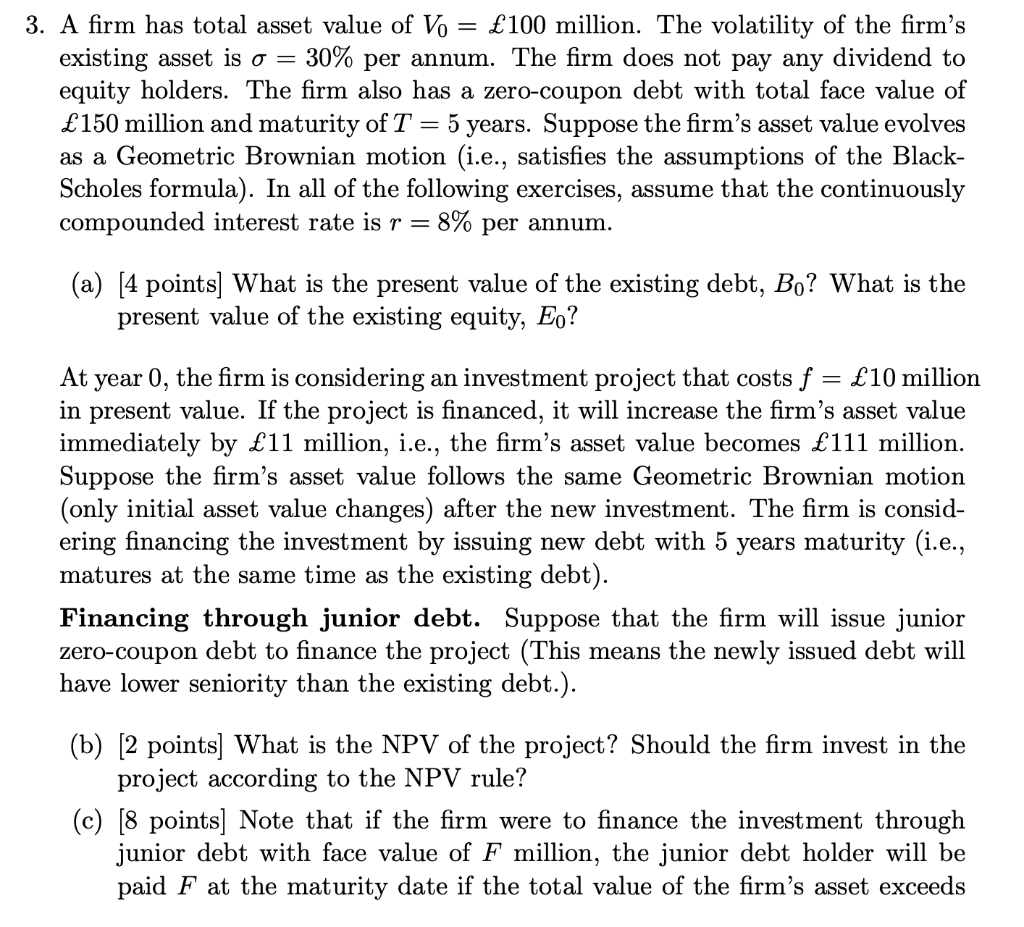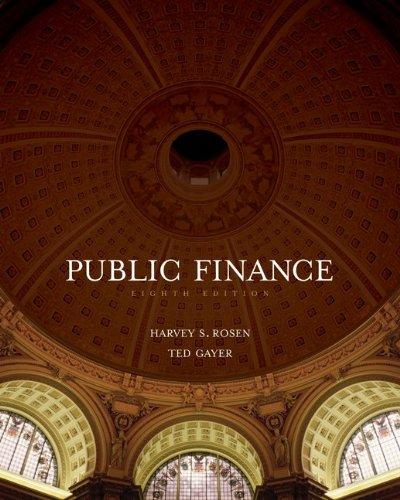

3. A firm has total asset value of Vo = 100 million. The volatility of the firm's existing asset is o = 30% per annum. The firm does not pay any dividend to equity holders. The firm also has a zero-coupon debt with total face value of 150 million and maturity of T = 5 years. Suppose the firm's asset value evolves as a Geometric Brownian motion (i.e., satisfies the assumptions of the Black- Scholes formula). In all of the following exercises, assume that the continuously compounded interest rate is r = 8% per annum. (a) [4 points) What is the present value of the existing debt, Bo? What is the present value of the existing equity, Eo? At year 0, the firm is considering an investment project that costs f = 10 million in present value. If the project is financed, it will increase the firm's asset value immediately by 11 million, i.e., the firm's asset value becomes 111 million. Suppose the firm's asset value follows the same Geometric Brownian motion (only initial asset value changes) after the new investment. The firm is consid- ering financing the investment by issuing new debt with 5 years maturity (i.e., matures at the same time as the existing debt). Financing through junior debt. Suppose that the firm will issue junior zero-coupon debt to finance the project (This means the newly issued debt will have lower seniority than the existing debt.). (b) [2 points] What is the NPV of the project? Should the firm invest in the project according to the NPV rule? (c) [8 points) Note that if the firm were to finance the investment through junior debt with face value of F million, the junior debt holder will be paid F at the maturity date if the total value of the firm's asset exceeds 3. A firm has total asset value of Vo = 100 million. The volatility of the firm's existing asset is o = 30% per annum. The firm does not pay any dividend to equity holders. The firm also has a zero-coupon debt with total face value of 150 million and maturity of T = 5 years. Suppose the firm's asset value evolves as a Geometric Brownian motion (i.e., satisfies the assumptions of the Black- Scholes formula). In all of the following exercises, assume that the continuously compounded interest rate is r = 8% per annum. (a) [4 points) What is the present value of the existing debt, Bo? What is the present value of the existing equity, Eo? At year 0, the firm is considering an investment project that costs f = 10 million in present value. If the project is financed, it will increase the firm's asset value immediately by 11 million, i.e., the firm's asset value becomes 111 million. Suppose the firm's asset value follows the same Geometric Brownian motion (only initial asset value changes) after the new investment. The firm is consid- ering financing the investment by issuing new debt with 5 years maturity (i.e., matures at the same time as the existing debt). Financing through junior debt. Suppose that the firm will issue junior zero-coupon debt to finance the project (This means the newly issued debt will have lower seniority than the existing debt.). (b) [2 points] What is the NPV of the project? Should the firm invest in the project according to the NPV rule? (c) [8 points) Note that if the firm were to finance the investment through junior debt with face value of F million, the junior debt holder will be paid F at the maturity date if the total value of the firm's asset exceeds 3. A firm has total asset value of Vo = 100 million. The volatility of the firm's existing asset is o = 30% per annum. The firm does not pay any dividend to equity holders. The firm also has a zero-coupon debt with total face value of 150 million and maturity of T = 5 years. Suppose the firm's asset value evolves as a Geometric Brownian motion (i.e., satisfies the assumptions of the Black- Scholes formula). In all of the following exercises, assume that the continuously compounded interest rate is r = 8% per annum. (a) [4 points) What is the present value of the existing debt, Bo? What is the present value of the existing equity, Eo? At year 0, the firm is considering an investment project that costs f = 10 million in present value. If the project is financed, it will increase the firm's asset value immediately by 11 million, i.e., the firm's asset value becomes 111 million. Suppose the firm's asset value follows the same Geometric Brownian motion (only initial asset value changes) after the new investment. The firm is consid- ering financing the investment by issuing new debt with 5 years maturity (i.e., matures at the same time as the existing debt). Financing through junior debt. Suppose that the firm will issue junior zero-coupon debt to finance the project (This means the newly issued debt will have lower seniority than the existing debt.). (b) [2 points] What is the NPV of the project? Should the firm invest in the project according to the NPV rule? (c) [8 points) Note that if the firm were to finance the investment through junior debt with face value of F million, the junior debt holder will be paid F at the maturity date if the total value of the firm's asset exceeds 3. A firm has total asset value of Vo = 100 million. The volatility of the firm's existing asset is o = 30% per annum. The firm does not pay any dividend to equity holders. The firm also has a zero-coupon debt with total face value of 150 million and maturity of T = 5 years. Suppose the firm's asset value evolves as a Geometric Brownian motion (i.e., satisfies the assumptions of the Black- Scholes formula). In all of the following exercises, assume that the continuously compounded interest rate is r = 8% per annum. (a) [4 points) What is the present value of the existing debt, Bo? What is the present value of the existing equity, Eo? At year 0, the firm is considering an investment project that costs f = 10 million in present value. If the project is financed, it will increase the firm's asset value immediately by 11 million, i.e., the firm's asset value becomes 111 million. Suppose the firm's asset value follows the same Geometric Brownian motion (only initial asset value changes) after the new investment. The firm is consid- ering financing the investment by issuing new debt with 5 years maturity (i.e., matures at the same time as the existing debt). Financing through junior debt. Suppose that the firm will issue junior zero-coupon debt to finance the project (This means the newly issued debt will have lower seniority than the existing debt.). (b) [2 points] What is the NPV of the project? Should the firm invest in the project according to the NPV rule? (c) [8 points) Note that if the firm were to finance the investment through junior debt with face value of F million, the junior debt holder will be paid F at the maturity date if the total value of the firm's asset exceeds








